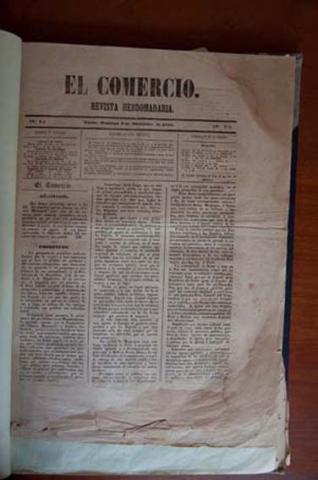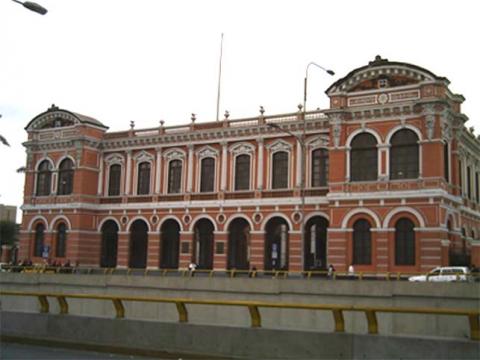Aims and objectives
The Lima Metropolitana Welfare Society Archive is an invaluable source for understanding Peruvian colonial history in matters as diverse as real estate ownership, public health or illegitimate children. The documentary fond holds documents from the 16th to the early 19th century. Regrettably, the preservation conditions are poor - badly stored, without a catalogue and lacking skilled professional staff, this is truly an endangered archive. Responding to the urgent need to preserve this repository, this team will undertake a pilot listing project to survey its extent and condition, as a preliminary to a future copying and preservation project.
Since its establishment, the Lima Metropolitana Welfare Society has been in charge of real estate and holding management of almost all the former colonial welfare institutions, especially the brotherhoods that owned real estate properties within the city of Lima and several farms in the surrounding valley during the 18th and 19th centuries. In that sense, and due to its role as administrator of welfare institutions, the Lima Metropolitana Welfare Society holds a large number of colonial documents dating from the 16th century. Its archives hold documents about foundations, benefactors, brotherhoods, chaplaincies, rural and urban properties, contracts, slaves, wills, payments letters, receipts and accounts records, which provide information on the daily operations of many charity institutions. These documents are especially valuable as sources of economic, social, religious, art and medicine history, as well as for studies of judicial and administrative processes. The historical value of this unique collection demands careful organisation and protection.
During colonial times (16th to early 19th centuries), the so-called houses of mercy within the Peruvian Viceroyalty relied on brotherhoods or societies sponsored by the Church authorities. The Royal Welfare Society was established in 1819, with the specific design to address the creation of a hospice for poor people, but began centralising all charity establishments and resources for building other houses of mercy.
During the Peruvian Republican Period, the houses of mercy ceased to be in charge of the clergy to become dependent on Public Welfare Societies. The Lima Welfare Society, as it functions until the present day, was instituted by a Presidential Decree of June 12, 1834. Its mission was to take care of welfare hospitals, hospices, and cemeteries, as well as brotherhoods or secular congregations for religious and philanthropic purposes, which dated back to the start of colonial times. All these were entrusted to the Lima Metropolitana Welfare Society since 1865.
At present the Lima Metropolitana Welfare Society Archive preserves documents dating from 1562 to 2000. A general inventory conducted in 2004 revealed that the Archive contains 4,544 files (legajos), 400 of which date back to colonial times. Another 481 files have never been catalogued. It is estimated that there are no more than 500 files left related to the colonial period, which mainly belong to the series Brotherhoods and Hospitals. These documents are unique, as with exception of some or other trial, they are not duplicated in Spanish archives. Neither is it possible to find them in Peruvian archives, although some series are divided between the Lima Metropolitana Welfare Society Archive, the Archbishoprie Archive of Lima (AAL) and the General National Archive (AGN).
The Archive is quite neglected, without any special care to prevent damage or theft. Presently, there is neither a proper catalogue nor trained staff to attend to researchers and visitors. Thus, consultation is restricted and the maintenance and search of documents could be much improved. Archival conditions are inappropriate for document conservation. The collection is sheltered in a colonial house built with adobe bricks (building material of sun-dried earth and straw) increasing the probability of deterioration by humidity, acarus and xylophagous. It has been established that at least 40% of the archival collection is in danger of data loss due to the oxidising process of ink where ink 'eats' paper. To secure future reproduction, it is imperative to undertake initial filing, basic cleaning and storing procedures. In addition to this, a sample of the documents will be digitised. This preliminary listing and initial filing will allow future inventorial control of the archival holdings and will ease researchers' consultation of the repository. It will also permit the public to consult the Archive through a printed catalogue.
A 2003 report made by the Peruvian National Archive revealed:
- A complete lack of archival organization, to the point that considerable documentation lies loose on the floor;
- Lack of an item-by-item catalogue;
- A research/reading room far away from archivist supervision;
- A reception desk located in the document storage room, jeopardising the integrity and protection of the collection.
A formal institutional agreement between the Pontificia Universidad Católica del Perú and the Lima Metropolitana Welfare Society assures the cooperation needed to complete the project.
Outcomes
The records copied by this project have been catalogued as:
- EAP234/1 Colonial Records
Due to the cyber-attack on the British Library in October 2023, the archives and manuscripts database is currently inaccessible and we are unable to provide links to the catalogue records for this project.




